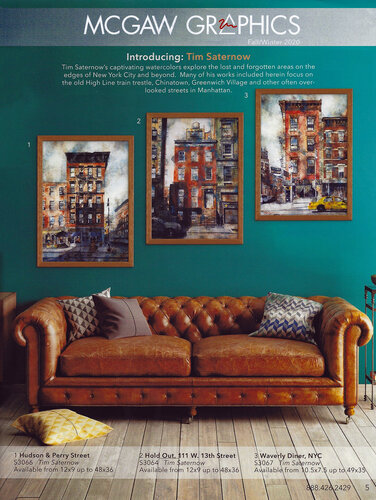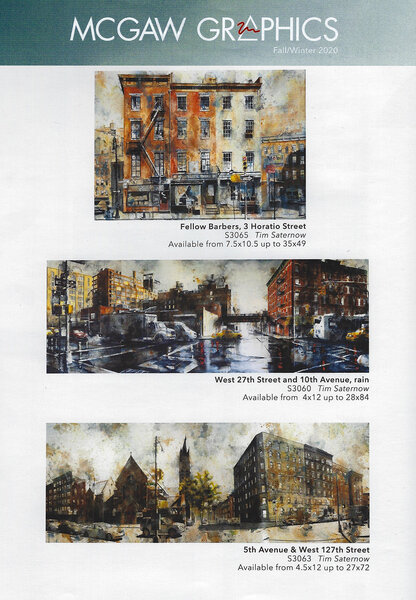Thinking of licensing your artwork? Painter Tim Saternow shares his experience and recommendations for artists interested in this channel.

Artist Tim Saternow with an original painting that was licensed, and assistant Rigby
Have you ever walked through an IKEA, West Elm, Pottery Barn, Target, or similar home store and thought, “Where do they find all this framed art?”
Welcome to the world of art publishing. These companies rent the right to duplicate artwork to be printed and sold. Products may be framed and wholesaled to home décor stores and beyond.
This is a passive income stream for you as the artist. It involves licensing your images to be widely reproduced and commercially distributed. Since this is passive income, you actually do very little except sign an agreement and send in your digital files. But beware, this is not a huge money maker for most artists (unless you have an image that just explodes in popularity). Your royalty earnings will probably be around ten percent.
Why would you agree to this rather small monetary deal? The most important reason is exposure–getting your art out there and building your reputation. This is a way to get your art noticed.

Licensed art by Tim Saternow shown in the McGaw Graphics catalog
The Art Publishing Industry
Art licensing involves working with companies such as art publishers that specialize in printed art that can be produced as posters and prints. Other manufacturers print art books or mass-produce merchandise of all types that feature images of beautiful art. I’m sure you’ve been through museum gift shops and have seen the wide variety of art from their own collection that is printed on everything from coffee mugs to umbrellas. Almost every major museum does this–and they make an incredible amount of money.
The range of products that can be printed ranges from small posters for $12 to large giclée prints on canvas for upwards of $200 if not more, depending on the size, surface and printing process.
Finding a Publisher
The task for the individual artist (the licensor) is finding a licensee which is a good match. Be sure that your art fits with their company aesthetic and inventory. They don’t come to you; you apply to them.
Start by doing a web search for art licensing companies or art publishing companies. Results will appear that are not only nationwide but also global. Some only market wholesale to the large home décor retailers, as mentioned earlier. Others will offer your artwork for sale directly to the public.
The real work is researching all these different companies. Go to each website and honestly determine whether your work will fit within their assortment of art. You’ll see immediately what range of work they present. You can easily reject the companies that don’t fit, or that only deal with very particular graphic work or photography.
All of this preliminary work is a great education in understanding the variety of work that is presented. Keep in mind that licensees are looking for images that are widely marketable. Unique subject matter or odd finished shapes may take a bit more work to find a company that shares your aesthetic.
Make yourself aware of each company’s categories for marketing: abstract, landscapes, western art, impressionism, and so on. Note how your work fits in with one or many of these categories.

Reproductions of Saternow’s work available for sale by art publisher McGaw Graphics
Negotiating the Deal
Apply to different art publishers and see what responses you get back. If a company responds and you begin to communicate, be very clear about what you are looking for. Decide what you want from a particular company that will represent you and your art. Ask questions. Do they note or spotlight their newer artists? Are they only marketing online or do they also send out hard copy catalogues? How often do they send royalty checks? Are there any hidden costs charged to the artist?
The length of your contract may also be an issue. Most contact agreements can be two or three years in duration. A good strategy is to ask for a tryout period of a short six to eight months initially. If agreed to, this is a great way to see how your art is presented and marketed, and how well it sells.
Remember that you, the artist, are approaching these companies from a position of strength. They are in competition with all other licensing companies for unique and beautiful artwork. There is no standard contract, so also remember this before you sign anything. It’s a mutual agreement, and you can ask for and negotiate what is important to you.
I’ve found that contacting other artists on the company’s roster can be very illuminating. And after a quick web search, emails are easily sent. Tell them you’re considering working with their licensing company and simply ask their opinion and experience.
A Helpful Guide
Whenever an artist is presented with an important contract, it can become confusing. I’ve found a wonderful and clear handbook on everything licensing and contracting, the Graphic Artists Guild Handbook: Pricing & Ethical Guidelines. The Graphic Artists Guild is a non-profit dedicated to helping protect artists who license their artwork. Since 1967, they’ve advocated for their members and for the industry as a whole in the legislative, judicial, and regulatory arenas. Find their website here.
Remember, do your research before agreeing to anything. Licensing your work can be an important component to making your art career even more successful.
Tim Saternow is an award-winning artist who paints in watercolor. He is also a resected art juror, workshop teacher, and his work has appeared in numerous museums and watercolor society exhibits around the U.S. and the world. Tim is currently on the board of the American Watercolor Society and is a Executive Fellow with the Clark Hulings Fund’s Art-Business Accelerator Program.


Speak Your Mind